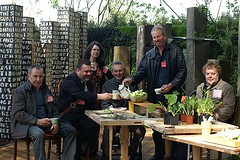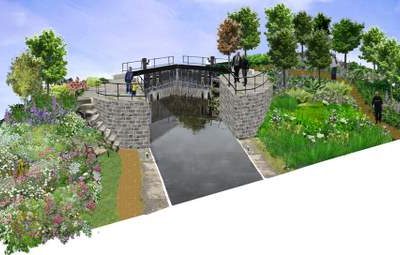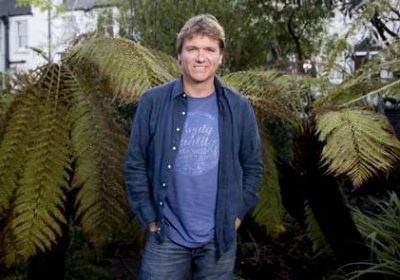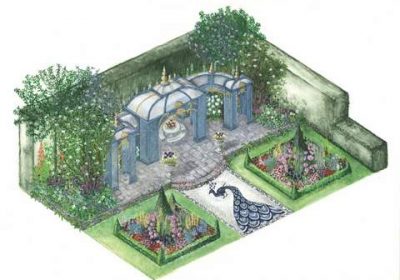The RHS Chelsea Flower Show, sponsored by M & G Investments, 25-29 May
The crème de la crème of the garden world will be wowing visitors at RHS Chelsea Flower Show 2010. Leading designers such as Tom Stuart-Smith, Tom Hoblyn, James Wong and Andy Sturgeon have drawn inspiration from literature, romance, the Far East and the Fynbos of South Africa, promising gardens to delight visitors. In contrast, the Eden and Leeds City Council gardens draw on influences closer to home including local communities and the British landscape. Here are some of the highlights of RHS Chelsea Flower Show 2010:
The ‘Places of Change’ garden by the Eden Project, will be the largest RHS Chelsea Show Garden ever built. It features five designated zones: crops and food; floristry and leisure; medicine and health; industry and manufacture which act as a metaphor for the hidden treasures that lie within communities and the most unexpected places. Eden’s Paul Stone is coordinating a team of experienced and novice garden designers on the project. These include amateur designers from the UK’s homeless centres.
Robert Myers, who has won four Gold medals and the RHS People’s Choice 2009 accolade, returns for a sixth time. ‘Enlighten’ is the theme of his design for Cancer Research UK. Robert has designed an ornamental, urban roof garden which celebrates the increased understanding of the causes, diagnosis and treatment of cancer, offering a beacon of hope.
Tom Stuart-Smith, who has won 9 Gold medals and 3 best in shows, will create for Laurent-Perrier a visionary garden of romance and elegance that offers a private, intimate space for entertainment or quiet reflection. The centrepiece of this modern garden will be a bronze Pavillion designed by award winning architect Jamie Fobert.
James Wong brings the exoticism of the Far East to RHS Chelsea Flower Show for Tourism Malaysia. His inspiration comes from the traditional ‘kampung’ (malay village) way of life. Elements of this rural idyll will be transposed to create a chic courtyard garden in urban Kuala Lumpur. The diverse planting will mix edible crops with rare pitcher plants, endangered bat lilies and unique orchids.
A re-creation of a section of the Leeds Liverpool Canal is the central feature of Leeds City Council’s The Hesco Garden. The design highlights the link between the natural landscape and public recreational space. This is demonstrated by an innovative planting scheme using hardy annuals, showing their versatility for gardeners with their extensive season stretching from early spring to the autumn.
Thomas Hoblyn’s design for Foreign Colonial Investment Trusts celebrates Voltaire’s eighteenth century classic, Candide. Set in a Turkish smallholding, it depicts the eponymous hero’s journey across oceans and rapids represented by two pools linked by a scalloped flowform. A risqué sculpture series depicts Candide’s love quest, Cunegonde, and her transformation from a precocious girl to a social climbing courtesan, thorough a series of lusty ‘thought bubbles’.
Phillipa Pearson and Jonathan Denby’s design for South Lakes Hotels – The Victorian Aviary Garden – moves forward a hundred years to the nineteenth century. The aviary is the central feature of this Cumbrian garden now used as an informal outdoor room with its two side wings planted with shrubs for year round interest. The aviary theme is reflected in other areas of the garden with a bird-themed mosaic path. The box edged borders combine late Victorian planting styles with a more modern approach.
The Daily Telegraph Garden designed by Andy Sturgeon is a contemporary gravel garden influenced by the Maquis shrubland of the Mediterranean, the Chaparral of California and Mexico, the Matorral of central Chile and Fynbos from the Southern Cape. Spaces within the garden are created by Cor-ten steel screens with linear natural stone paths leading to a courtyard dominated by a stately cork oak. The sound of water creates a contemplative, spiritual space.
The Children’s Society Garden designed by Mark Gregory has been inspired by The Children’s Well-Being report. The survey of nearly 7,000 10 – 15 year olds revealed that what made children most happy were their family, friends and having freedom of choice. The garden reflects this need with a covered lounge seating area where families can unwind and relax around a safely designed fire pit.
Please note: information is subject to change
Cancer Research UK
Designer Name:Robert Myers Associates
This is a stylish and elegant ornamental, urban roof garden inspired by the sponsor’s chosen theme of ‘Enlighten’. This celebrates how the work of Cancer Research UK has shed light and increased understanding of the causes, diagnosis and treatment of cancer, and offers a beacon of hope. The theme of ‘Enlighten’ is represented conceptually as a ‘journey’ towards calm, order, serenity and rationality; physical concepts of enlightenment are explored in the use of light and shade, shadow and contrast. A path composed of granite ‘planks’ winds through a grove of white-stemmed birch under-planted with monochrome herbaceous woodland planting, and emerges onto a terrace surrounded by more colourful, vibrant planting. As the path moves towards a central terrace, the rough stone path becomes more regular and smooth, and the colour of the stone lightens.
The garden is surrounded by a slatted timber ‘cloister’ creating vistas and ever-changing shadows, and the terrace is over-sailed by a dramatic slatted canopy with a central circular opening over a circular reflecting pool. Smaller circular pools of water are scattered through the planting and bring reflected light and gentle movement into the garden. At the rear of the garden the planting gradually becomes more formal and regular with the introduction of a grid of clipped box cubes.
Designer Name:Eden Project
This is a shared garden that will rely upon involvement, collaboration and cooperation and so draw the participant into the ongoing story of Places of Change. The garden will draw on the values and perceptions that shape society and the moves we make to shape our lives. The garden will present a series of achievements and aspirations built around the people who are least likely to be heard and most likely to surprise us. It will demonstrate, through living examples, how horticulture is the foundation for so many opportunities to build skills, provide space, allow recovery, grow business and adapt to changing and difficult times.
Foreign Colonial Investment Trusts
Designer Name:Thomas Hoblyn Garden Design Ltd
The field-like layout of the garden is suggestive of the Turkish smallholding where Candide’s final words are spoken and the planting adds an appropriate Mediterranean flavour. The two pools represent the oceans that Candide crosses in his travels linked by a scalloped flowform designed to mimic the rapids of the river that shipwrecks Candide’s canoe upon entry to El Dorado. Stone-clad and planted walls represent the steep cliffs that surround El Dorado. Love interest Cunégonde and her transformation from coquettish girl to social climbing courtesan is depicted in the sculpture series as Candide’s lusty ‘thought bubbles’ in his trans-global pursuit to have her. With the addition of furniture and pots this becomes a feasible garden that could easily be found in the warmer parts of the UK and it demonstrates new possibilities of exotic plant use due to recent climate change.
Laurent Perrier (UK) Ltd –
Designer Name:Tom Stuart-Smith
A modern garden of subtle and varying textures: the centrepiece is an elegant,bronze Pavilion designed by award winning architect Jamie Fobert.
The Pavilion is constructed from folded sheets of patinated copper; overlooking an elongated pool of water and Spring woodland planting, it contrasts with the naturalism around it. A rectilinear pattern of paths guides the viewer through the curve of the trees, whilst natural stone provides a rich textured wall around the garden.
The planting consists of three elements: a grove of Betula, River Birch, two hedges of cloud pruned Box, and woodland planting dominated by fresh white flowers, woodland grasses, Euphorbias and Blue Iris siberica, which contrast to the strength and darkness of the bronze.
Designer Name:Leeds City Council, Parks and Countryside
The recreational space has been designed with maintenance in mind, in particular the choice of plants and planting approach demonstrates a new way of using hardy annuals in a naturalistic way, with a season of interest that extends from early spring through to autumn. All planting is chosen for its value in supporting and encouraging local wildlife and conservation.
The Daily Telegraph
Designer Name:Andy Sturgeon Garden Design
The Children’s Society
Designer Name:Landform Consultants
In a survey of almost 7,000 10-15 year-olds conducted by The Children’s Society, children and young people said what made them happiest was their family, friends and having freedom and choice in their lives, now and in the future. Their local area was one of the things that made them least happy.
The Children’s Society Garden reflects these findings, providing a retreat for the family, friends and neighbours to get together. The covered lounge seating area is an ideal place for the family to unwind around a safely designed fire pit. The area is vented and surrounded by curtains for privacy and warmth. The family can relax in the naturally filtered plunge pool or make pizzas in the large outdoor oven.
The Children’s Society Garden is a modern, urban haven that takes inspiration from what makes children and young people happy and delivers it with style.
South Lakes Hotels – The Victorian Aviary Garden
Designer Name:Philippa Pearson & Jonathan Denby
An ornate Victorian aviary has been restored and adapted in a section of a larger garden creating an enchanting focal point and an informal outdoor room for relaxation, eating al fresco and enjoyment of the garden. The two side wings of the aviary, once used to keep exotic birds in during its Victorian heyday, are now planted with shrubs for year round interest. The restored aviary is typical of the grand designs from the late Victorian period, an era appreciated by the garden owners.
Located in Cumbria, the garden uses local materials including Cumbrian slate for paving and limestone for the traditional stone walls on the terrace, typically found in this region of the UK. The avian theme is reflected into other areas of the garden including a bird-themed pebble mosaic path designed by Maggy Howarth.
Tourism Malaysia
Designer Name:Amphibian Designs
Inspired by the traditional “kampung” (malay village) way of life, the design takes elements of an idyllic, rural lifestyle and interprets them through a chic, ultra modern lense, to create a landscape steeped in ancient heritage, while simultaneously being at the very cutting edge of international design.
The garden is envisioned as the courtyard of an urban residence in the heart of downtown Kuala Lumpur, and will contrast terraces of minimalist, angular hard landscaping with lush swathes of wild, naturalistic tropical planting. Here, instead of taking its creative inspiration from the ubiquitous Balinese or Thai garden styles, which have been reproduced indiscriminately throughout the tropics, the design will instead be unashamedly and uniquely Malaysian. The scheme’s planting, for example, will use a palette of species iconic of Kampung gardens, most of which are usually considered purely edible crops, yet have an immense ornamental potential that is often over looked. These include the stunning paddles of fruiting banana trees and the swaying trunks of mature coconut palms, all under planted with yams, gingers & lemongrass.
As in a real-life kampung, the planting palette of crops are enriched with species from the surrounding rainforest, which are blessed with some of the most astonishing biodiversity on earth, including the rare and unusual pitcher plants, endangered bat lilies and bizarre orchids found no-where else on earth. In this scheme imported ornamentals, such as the frangipani and the traveller’s palm, are replaced in favour of rare native species unknown to even most Malaysians, such as the iridescent leaves of the endangered Peacock begonia (only found in the mountains of Pahang) & the delicate arching fronds of the elegant Matonia fern, endemic to the peninsula’s highlands.
Details of the RHS Chelsea Flower Show sponsors M & G Investments garden and the gardens listed below will follow shortly
Fleming’s Nurseries
Designer Name:TLC
Ishihara Kazuyuki Design Laboratory
Designer Name:Ishihara Kazuyuki Design Laboratory
Designer Name:James Towillis
Designer Name:Darren Saines DA






